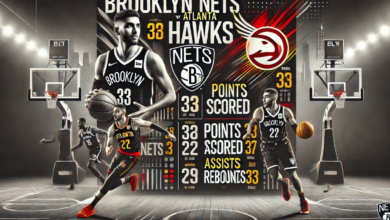Introduction
The rivalry between the Chicago Bulls and Los Angeles Lakers is one of the most storied in NBA history. Spanning decades, this matchup has seen some of basketball’s greatest players go head-to-head, crafting moments that have etched themselves into the hearts of fans worldwide. From Michael Jordan’s dominance in the 90s to the electrifying Chicago Bulls vs Lakers performances of Kobe Bryant and LeBron James, these games are more than just battles—they are spectacles that define eras.
In this article, we take a deep dive into the statistics of one key game that encapsulates the excitement of this rivalry. By examining team performances and individual contributions, we uncover the stories behind the numbers, offering insights into strategies, key moments, and standout players. Let’s dissect the numbers to understand why this game holds a special place in basketball lore.
Historical Context
The Rivalry Over the Decades
The Chicago Bulls and Los Angeles Lakers have a rivalry rooted in their dominance over different periods in NBA history. The Lakers ruled the 80s, led by Magic Johnson, Kareem Abdul-Jabbar, and James Worthy, while the Bulls owned the 90s with Michael Jordan and Scottie Pippen at the helm. Despite their peaks being in different decades, the two teams have faced off in memorable showdowns that have captivated fans.
A significant chapter in this rivalry unfolded during the 1991 NBA Finals, where Jordan’s Bulls dethroned Magic’s Lakers in a five-game series. Fast forward to the modern era, and the dynamic has shifted again with LeBron James leading the Lakers and the Bulls building a young, promising roster. Each game between these franchises feels like a renewal of an epic story, driven by legacy and the pursuit of greatness.
The Significance of the Match in Focus
The game analyzed here took place in the regular season, yet it carried the intensity of a playoff showdown. For the Bulls, it was a chance to prove their mettle against one of the NBA’s top contenders. For the Lakers, it was an opportunity to assert their dominance and showcase the synergy of their star players.
Pre-game discussions were centered on key matchups, such as Zach LaVine vs. LeBron James and Nikola Vučević battling Anthony Davis in the paint. Both teams came in with something to prove, making this not just another game, but a statement of intent.
Team Performance Overview
Chicago Bulls Team Stats
The Bulls delivered a well-rounded performance, showcasing their offensive firepower and defensive resilience. They shot an impressive 48% from the field, with key contributions from Zach LaVine, who tallied 28 points, and DeMar DeRozan, who added 25. The team’s ball movement was notable, recording 28 assists, a testament to their unselfish play.
Defensively, the Bulls were active, racking up nine steals and forcing 15 Lakers turnovers. Their ability to transition quickly from defense to offense Chicago Bulls vs Lakers kept the Lakers on their heels. However, their struggles in rebounding, particularly on the defensive end, allowed the Lakers multiple second-chance points, highlighting an area for improvement.
Los Angeles Lakers Team Stats
The Lakers, on the other hand, leaned heavily on their star duo, LeBron James and Anthony Davis. LeBron’s 32-point, 10-assist performance was a masterclass in leadership, while Davis dominated the paint with 25 points and 15 rebounds. The team’s field goal percentage stood at 45%, slightly lower than the Bulls but offset by their strong presence on the boards.
Defensively, the Lakers excelled in blocking shots, with Davis accounting for four of the team’s seven blocks. However, their perimeter defense faltered, allowing the Bulls to hit 38% of their three-point attempts. The Lakers’ reliance on isolation plays also limited their overall offensive efficiency.
Comparative Analysis
When comparing the two teams, the Bulls excelled in perimeter shooting and ball movement, while the Lakers’ dominance in the paint and rebounding kept them competitive. The game was a clash of contrasting styles—Chicago’s fast-paced, team-oriented approach versus Los Angeles’ star-driven strategy. In the end, the ability to capitalize on turnovers and maintain shooting efficiency gave the Bulls a narrow edge.
Individual Player Stats: Who Stood Out?
Chicago Bulls Top Performers
Zach LaVine was the Bulls’ standout performer, showcasing his scoring prowess with 28 points on 55% shooting. His ability to drive to the basket and hit mid-range jumpers kept the Lakers’ defense guessing. DeMar DeRozan complemented LaVine’s efforts with 25 points and six assists, providing a steady presence in crunch moments.
Role players also made significant contributions. Alex Caruso, a former Laker, added intensity on defense, recording three steals and disrupting the Lakers’ offensive flow. Vučević’s 15-point, 10-rebound performance highlighted his importance as the Bulls’ anchor in the paint.
Los Angeles Lakers Top Performers
LeBron James was as dominant as ever, recording a double-double with 32 points and 10 assists. His court vision and ability to control the game’s tempo were on full display. Anthony Davis’ defensive and offensive contributions were equally impactful, with his 25-point, 15-rebound outing solidifying his role as the Lakers’ backbone.
Despite the stars’ brilliance, the Lakers struggled to find consistent support from their bench. Malik Beasley and Rui Hachimura chipped in with key buckets, but their contributions weren’t enough to tip the scales.
Key Matchups and Battles
The game’s defining moments often came down to individual battles. LaVine’s ability to score over LeBron and Davis in clutch moments swung momentum in the Bulls’ favor. Meanwhile, Davis’ interior defense against Vučević kept the game competitive, showcasing the importance of star power in critical matchups.
Statistical Trends and Insights
Offensive and Defensive Patterns
The Bulls excelled in transition, scoring 20 fast-break points compared to the Lakers’ 12. Their ability to capitalize on turnovers—scoring 18 points off 15 Lakers’ errors—was a key factor in their victory. Defensively, Chicago’s perimeter pressure limited the Lakers’ three-point shooting to just 32%.
Game-Changing Moments
One of the pivotal moments occurred in the fourth quarter when the Bulls went on a 12-2 scoring run, fueled by back-to-back three-pointers from LaVine. On the defensive end, Caruso’s steal and fast-break assist to DeRozan sealed the momentum shift, ensuring the Bulls maintained their lead.
Lessons Learned from the Stats
The game highlighted the importance of bench contributions, perimeter shooting, and transition offense. For the Lakers, it was a reminder of the need for consistent support beyond their stars, while the Bulls demonstrated the effectiveness of teamwork and defensive hustle.
Conclusion
This matchup between the Chicago Bulls and Los Angeles Lakers was a masterclass in basketball strategy and execution. While the Bulls emerged victorious, the game showcased the brilliance of both teams’ star players and their contrasting styles of play. By analyzing the stats, we gain a deeper appreciation for the nuances that make these games memorable.
As the rivalry continues, fans can look forward to more thrilling encounters, each adding a new chapter to the legacy of the Bulls and Lakers.
FAQs
- Why is the Chicago Bulls vs. Lakers rivalry significant?
- The rivalry is significant due to the teams’ storied histories, iconic players, and memorable matchups that have shaped NBA culture.
- Who were the standout players in this game?
- Zach LaVine and DeMar DeRozan for the Bulls, and LeBron James and Anthony Davis for the Lakers, were the standout performers.
- What were the key statistical highlights?
- The Bulls excelled in perimeter shooting and fast-break points, while the Lakers dominated in rebounding and shot-blocking.
- How did the teams’ strategies differ?
- The Bulls focused on ball movement and perimeter pressure, whereas the Lakers relied on their stars and interior dominance.
- What does this game mean for future matchups?
- It sets the stage for intense, competitive games, with both teams learning from their strengths and weaknesses revealed in this clash.
You may also read:https://booksnews.co.uk/red-sox-vs-yankees-match-player-stats/




